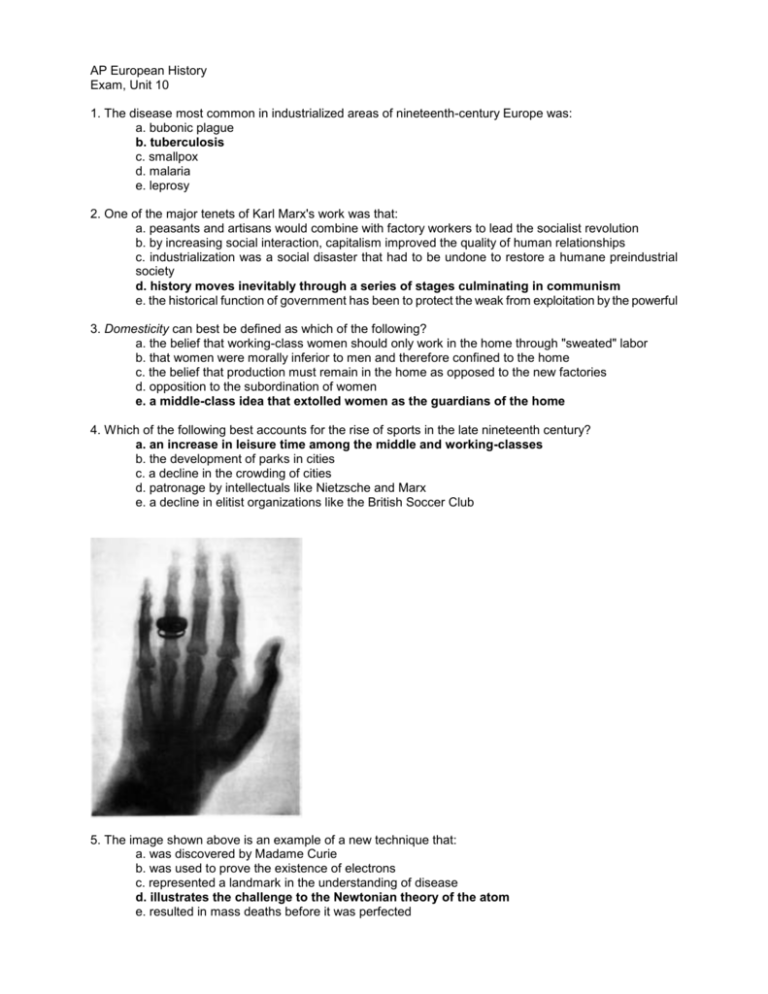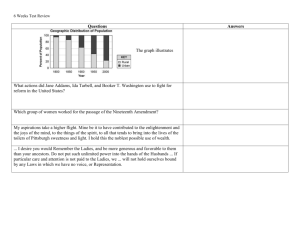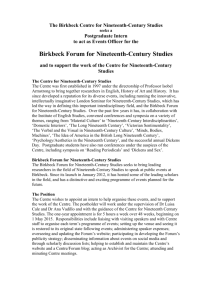Unit 10
advertisement

AP European History Exam, Unit 10 1. The disease most common in industrialized areas of nineteenth-century Europe was: a. bubonic plague b. tuberculosis c. smallpox d. malaria e. leprosy 2. One of the major tenets of Karl Marx's work was that: a. peasants and artisans would combine with factory workers to lead the socialist revolution b. by increasing social interaction, capitalism improved the quality of human relationships c. industrialization was a social disaster that had to be undone to restore a humane preindustrial society d. history moves inevitably through a series of stages culminating in communism e. the historical function of government has been to protect the weak from exploitation by the powerful 3. Domesticity can best be defined as which of the following? a. the belief that working-class women should only work in the home through "sweated" labor b. that women were morally inferior to men and therefore confined to the home c. the belief that production must remain in the home as opposed to the new factories d. opposition to the subordination of women e. a middle-class idea that extolled women as the guardians of the home 4. Which of the following best accounts for the rise of sports in the late nineteenth century? a. an increase in leisure time among the middle and working-classes b. the development of parks in cities c. a decline in the crowding of cities d. patronage by intellectuals like Nietzsche and Marx e. a decline in elitist organizations like the British Soccer Club 5. The image shown above is an example of a new technique that: a. was discovered by Madame Curie b. was used to prove the existence of electrons c. represented a landmark in the understanding of disease d. illustrates the challenge to the Newtonian theory of the atom e. resulted in mass deaths before it was perfected 6. All of the following were components of the British social welfare program as it developed between 1906 and 1916 EXCEPT: a. a minimum-wage law b. old-age pensions c. guaranteed annual income of 500 £ d. accident and sickness insurance e. unemployment benefits 7. Albert Einstein's theory of relativity proposed: a. a new structure for the atom b. a new conception of time and space c. the fundamental concepts for developing the computer d. the origin of the universe from the explosion of a single mass e. the particle nature of light 8. All of the following were aspects of life in the largest cities of Western Europe during the latter half of the nineteenth century EXCEPT: a. increased availability of public housing b. sensationalist tabloid newspapers covering both national and international news c. significant numbers of workers responsive to socialist ideology d. declining standards of public health and life expectancy e. development of transportation systems and parks POPULATION GROWTH IN THE NINETEENTH CENTURY Population Size Average Growth (millions) Rates per annum ________________________________________________________________________________________ 1800 1850 1900 1800-50 1850-1900 ________________________________________________________________________________________ France 28 36 41 0.47% 0.25% Great Britain 11 21 37 1.30% 1.14% 9. The difference between French and British population growth was primarily caused by: a. earlier adoption of birth control in Great Britain b. earlier adoption of birth control in France c. higher level of infant mortality in Great Britain d. higher reproduction rate in France e. great loss of population in France due to wars 10. Which of the following best characterizes the social structure of the German Empire in 1871? a. A conservative compromise between the old aristocracy and the new middle class b. The triumph of the middle class c. An equitable federation of the traditional German states d. An amicable compromise between the middle class and the industrial proletariat e. The triumph of the industrial east over the agrarian west 11. By the 1870s, most Western European governments had begun to provide all of the following EXCEPT: a. primary schooling for children b. safety inspection of factories c. public parks, museums, and libraries d. municipal water and sewage disposal in urban areas e. an extensive social welfare state 12. The symbol above advocates the union in political action of which of the following classes or groups in Italian society? a. Intellectuals, priests, and industrialists b. Workers, peasants, and intellectuals c. Students and civil servants d. Workers and priests e. Industrialists and intellectuals 13. Which of the following is most closely associated with anarchism? a. The assassination of major political leaders. b. The use of industrial strikes to gain better wages. c. The split between the Mensheviks and the Bolsheviks. d. The formation of the Fabian Society. e. The idea of Karl Marx and Friedrich Engels. PERCENTAGE OF TOTAL POPULATION LIVING IN CITIES OF 20,000 OR MORE Year 1801 /////////////////////////// 17% 1851 //////////////////////////////////////////////////////// 35% 1891 /////////////////////////////////////////////////////////////////////////////////////////////// 51% 14. The chart above depicts the process of urbanization in: a. Austria-Hungary b. Great Britain c. France d. Russia e. Spain and Portugal 15. All of the following statements regarding changes that occurred in religious life of Western Europe between 1870 and 1914 are true EXCEPT: a. Many Protestant groups became divided between fundamentalists and modernists. b. The Roman Catholic Church was slower to adapt to cultural change than were Protestant groups. c. Most Jewish communities rejected urbanization and assimilation. d. The status of religion generally in Western Europe was undermined by growing materialism. e. Churches' traditional role in education and social welfare was being taken over by the state. 16. Which of the following best describes an important trend in typical family size in Western Europe after 1870? a. It increased in urban areas due to improvements in public health and housing for workers. b. It decreased in working-class families due to legislation limiting child labor. c. It decreased sharply because of chronic food shortages. d. It decreased initially in the middle classes because of the increased costs of rearing children. e. It remained unchanged because of massive emigration overseas. "Where liberal parties, now liberal only in name, remained in power, they embraced protectionism and imperialism, undertook social regulation, and retained from the old liberal creed only opposition to the extension of the franchise and to the church." 17. In what era did the developments described in the passage most probably take place? a. 1715-1788 b. 1789-1800 c. 1815-1830 d. 1850-1871 e. 1880-1905 18. Which of the following factors best explains the transformation and decline of liberalism described in the above passage? a. The continued deference of peasants to aristocratic influence b. The rise of industrial society and of mass political movements c. The general decline in literacy rates d. The inability of laissez-faire economics to uproot traditional communal agriculture and guilds e. A strong popular reaction against liberal anti-clericalism 19. Which of the following ideas did Darwin draw on in developing his theories of evolution? a. The Romantics' ideas about the importance of heroic individuals b. The scientific view that species are eternal and unchanging c. The Biblical account of creation in Genesis d. Nineteenth-century theories of racial superiority e. The population theories of Thomas Malthus 20. The immediate cause of the 1905 Russian Revolution was social strain resulting from: a. the agitation of the Russian Social Democratic party b. the mass emigration of skilled workers to the New World c. attempts by the government to reform the Russian Orthodox Church d. the demands of ethnic groups for political autonomy e. Russian losses in the Russo-Japanese War 21. When Sigmund Freud remarked that "in mental life nothing which has once been formed can perish," he meant that: a. human beings are rational creatures b. human beings can remember and recall all experiences at will c. all mental acts are conscious mental acts d. the unconscious preserves unpleasant as well as pleasant thoughts e. the unconscious obliterates excess thoughts 22. In late nineteenth-century Great Britain, women were in the majority in which of the following categories of employment? a. transportation b. mining c. factory work d. domestic service e. construction work 23. Which of the following scientific theories of the nineteenth and twentieth centuries was used to support notions of racial superiority? a. Nietzsche's theory of "will to power" b. Freud's psychoanalytic theory c. Darwin's theory of natural selection d. Planck's quantum theory e. Pavlov's theory of conditioned response 24. Which of the following European states was the last to eliminate legal discrimination against Jews? a. Austria-Hungary b. France c. Great Britain d. Italy e. Russia 25. Which of the following reforms in the mid-nineteenth century does NOT belong with the appropriate nation? a. France—rebuilding of Paris b. Great Britain—codes of public housing and health c. Russia—creation of local assemblies d. Austria-Hungary—independence for Slavic minorities e. Germany—adoption of social welfare system 26. Which is most closely associated with revisionist socialism? a. First International (1864) b. Mikhail Bakunin c. German Social Democratic Party d. National Federated Trade Union e. Frederick Engels 27. Which of the following developments provided women with a degree of personal autonomy in the period, 1870-1914? a. winning the right to vote in most European nations b. protective legislation that banned female factory work c. creation of white-collar jobs such as clerks and secretaries d. land redistribution for the establishment of family farms e. many female politicians becoming the heads of government 28. Which of the following ideas is common to the works of both Karl Marx and the classical economists? a. The overthrow of the bourgeoisie by the revolutionary proletariat is inevitable. b. Class struggle is the mechanism of historical progress. c. The free exchange of wages for labor ensures social harmony. d. The value of a product is largely determined by the value of the labor used to produce it. e. The triumph of the proletariat will bring about a classless society. 29. Albert Einstein is well known for theorizing that: a. atoms are stable, basic building blocks of nature b. time and space are unconnected concepts c. lights contains energy only when it is visible d. mass and energy are interconvertible e. the speed of an aircraft cannot exceed the speed of sound 30. In On the Origin of Species, Charles Darwin addresses the: a. bases of the British constitution b. need to protect endangered species from extinction c. transmutation over time of plant and animal life d. effect of gravity on the orbits of the planets e. inevitable disappearance of human beings 31. Which of the following was a major demographic change in Western Europe between 1850 and 1914? a. A dramatic shift of population to urban areas b. A rapidly increasing birth rate c. A rapidly decreasing death rate d. A pronounced trend toward larger families e. A marked decline in emigration 32. Which of the following is one of Sigmund Freud’s most significant contributions to twentieth-century thought? a. Spontaneous affection is harmful. b. Unconscious psychological energy is sexual energy. c. Dreams are unrelated to waking thought. d. Family life has little to do with mental illness. e. Each individual’s personality is predetermined by genetics. 33. Claude Monet is associated with the beginnings of the artistic movement known as: a. Romanticism b. Impressionism c. Realism d. Dadaism e. Cubism 34. Which of the following was a result of Einstein’s publication of the special theory of relativity in 1905? a. The quantum theory of Max Planck was disproved. b. The accomplishments of Pierre and Marie Curie were rendered obsolete. c. Basic assumptions of classical physics about space and time had to be revised. d. Nations of the world immediately began an intensive research effort to create an atomic bomb. e. Physicists concentrated on developing a method of traveling faster then the speed of light. 35. The map above best supports which of the following statements? a. Religious affiliation explains the growth of the population. b. Immigration to the Western Hemisphere decimated the population of central Germany. c. The Franco-Prussian and Austro-Prussian Wars left Germany divided and depopulated. d. The population of industrial regions grew most rapidly. e. The influx of Russians and Eastern Europeans made Germany the largest multinational state in Europe. 36. During the nineteenth and twentieth centuries, the first European country to experience a dramatic decrease in its birth rate was: a. France b. Italy c. Russia d. Spain e. Germany 37. Between 1870 and 1914, the heavily industrialized nations of Western Europe earned the loyalty of their citizens by all of the following EXCEPT: a. extending the right to vote to almost all adult males b. acquiring colonies to promote economic expansion and national pride c. dividing farmland equally among peasants d. increasing the availability of public education e. legalizing trade unions 38. The rebuilding of Paris during the 1850s and 1860s resulted in the: a. reduction of open spaces for recreation b. improvement of military fortifications c. prevention of popular uprisings in the city d. destruction of much working-class housing e. concentration of population in the central area of the city 39. Which of the following resulted from the Russian Revolution of 1905? a. Emancipation of the serfs b. Legalization of the Bolshevik party c. Universal suffrage d. A free press e. The creation of the Duma 40. Which of the following advocated an evolutionary, as opposed to a revolutionary, theory of Marxism? a. Eduard Bernstein b. V.I. Lenin c. Rosa Luxembourg d. Joseph Stalin e. Karl Marx 41. The revolution in understanding the nature, treatment, and prevention of infectious diseases was largely due to the discoveries of: a. Darwin, Huxley, and Wallace b. Herder, Chateaubriand, and de Stael c. Weber, Lombroso, and Nietzsche d. Durkheim, Pavlov, and Mendel e. Jenner, Lister, and Pasteur 42. “I accuse the war office of having led a vile campaign in the press in order to misdirect public opinion and over up its sins. I accuse the first court-martial of having violated all human rights in condemning a prisoner on testimony kept secret from him.” This quotation above by Emile Zola was written to: a. protest against the trials of the Jacobin government during the Reign of Terror b. defend Napoleon III after defeat in the Franco-Prussian War c. protect the reputation of General Boulanger d. challenge the tactics of the French army in colonial campaigns e. attack the actions of the French military during the Dreyfus Affair 43. In the period between 1871 and 1914, European governments regarded public education for the masses as important primarily because it would: a. discourage emigration to the New World b. ensure that children received comprehensive religious instruction c. ensure that laborers were informed participants in the union movement d. provide society with well-informed and responsible citizens e. lead to female suffrage 44. The major reason for the pattern shown in the graph above is: a. parents’ decision to have smaller families b. a declining standard of prenatal care for pregnant women c. a decrease in the marriage rate for women d. increased use of birth control pills e. the spread of infanticide 45. Which of the following best describes the relationship of the western European working class to organized religion in the late nineteenth century? a. Renewed and strengthened by religious revivalism b. Strengthened by church support for unions c. Weakened, especially in highly industrialized areas d. Weakened, especially in Ireland e. Solidified and stable 46. The new physics caused much scientific controversy in the early twentieth century primarily because it: a. led to the use of x-rays for medical diagnosis b. inspired the first attempts to build an atomic bomb c. placed Germany at the forefront of fundamental scientific research d. challenged traditional notions of causality, time, and space e. showed that God could not intervene in the universe except spiritually 47. When Charles Darwin published On the Origins of Species in 1859, he used the phrase “origin of species” to mean which of the following? a. The beginning of life on Earth b. The original appearance of the species first described in Genesis c. The earliest distillation of genera into species d. The transmutation of any species into another over time e. The degeneration of primal species into variations 48. “The history of all hitherto existing societies is the history of class struggles.” This quotation is from the writings of: a. Robespierre and Danton b. Saint-Simon c. Marx and Engels d. Malthus e. Bismarck 49. The growth in Europe’s population in the late nineteenth century can be attributed primarily to: a. falling mortality rates b. a decline in emigration c. a growing trend toward larger families d. falling marriage rates in western Europe e. population growth rates that were higher in western than central Europe 50. Of the following, which was the central issue for nineteenth-century European advocates of women’s rights? a. The right of women to control their own property b. Equal pay for equal work c. The right to serve in the military d. The right to enter the professions e. The right to civil marriage ceremonies 51. The first European country to develop a state social welfare system was: a. Great Britain b. Sweden c. France d. Belgium e. Germany 52. All of the following concepts are associated with Sigmund Freud’s theories of psychoanalysis EXCEPT: a. superego b. early sexuality c. collective unconscious d. Oedipus complex e. repression 53. "His scientific discoveries relating to disease in the nineteenth century led to the first antiseptics, food purification, and ultimately a higher life expectancy in the twentieth century." Who is the scientist being described? a. Joseph Lister b. Marie Curie c. Louis Pasteur d. Albert Einstein e. Gregor Mendel 54. Which of the following is the best characterization of urban life in second half of the nineteenth century in western Europe? a. standards of living and sanitation rapidly declined as cities grew b. governments quickly moved in to provide public housing to meet shortages c. neighborhoods became more divided on the basis of class d. problems such as prostitution and violence were eliminated through grassroots reform e. continual working-class riots led to declining economic productivity 55. All of the following represent significant changes in urban life in the period 1870-1914 EXCEPT: a. municipal provision of public parks and recreation areas b. the creation of sewage and sanitation systems c. the destruction of medieval walls and creation of boulevards d. municipal provision of cultural amenities, such as opera houses and museums e. government guarantees of public housing for the poor and homeless 56. Which of the following statements best reflects the ideas of Karl Marx? a. Population grows in geometric progression. b. Humans share a common ancestry with apes. c. The market is governed by the invisible hand. d. A classless society will emerge at the end of the dialectical process. e. Happiness results from the greatest good for the greatest number. 57. Which of the following statements best describes Charles Darwin’s theory of evolution? a. Changes in species result from periodic catastrophic geological events that alter the environment. b. All creatures living today descended from a single common ancestor in an inevitable process. c. The emergence of new species, as in the fossil record, is attributable solely to genetic mutations. d. Species tend to reproduce geometrically but their subsistence grows arithmetically. e. New species emerge after gradually accumulating new modifications. 58. The Dreyfus Affair in late nineteenth-century France resulted in which of the following? a. The fall of the Third Republic b. The deepening of political divisions c. The establishment of universal suffrage d. War with Germany e. Reform of the monetary system 59. The artistic technique depicted above is associated with which of the following periods? a. Italian Renaissance b. Eighteenth-century Rococo c. Nineteenth-century Romanticism d. Nineteenth-century Realism e. German Expressionism 60. Two of the leaders in the nineteenth-century development of the germ theory of disease were: a. Marie Curie and Max Planck b. Gregor Mendel and Auguste Comte c. John Dalton and Michael Faraday d. Louis Pasteur and Robert Koch e. Jonas Salk and Francis Crick 61. Which of the following is most closely associated with Friedrich Nietzsche? a. Creation of Israel as a religious state b. Protective legislation concerning child labor c. The elimination of all trade barriers and tariffs d. The right of women to own property e. The rejection of bourgeois morality 62. Which of the following is an accurate description of the outcome of the Paris Commune? a. The Commune overthrew Napoleon III. b. The Commune successfully defended Paris against the Prussian army. c. The Commune successfully established a liberal democratic government in France. d. The Commune was crushed by the French army. e. The Commune promoted a reconciliation between French Catholics and socialists. “O highest and most marvelous felicity of man! To him it was granted to have whatever he chooses, to be whatever he wills.” 63. The excerpt above is representative of the ideas of a. Jean-Jacques Rousseau, Social Contract b. Thomas Hobbes, Leviathan c. Pico della Mirandola, On the Dignity of Man d. Martin Luther, Address to the Christian Nobility of the German Nation e. Karl Marx and Friedrich Engels, Communist Manifesto “The whole history of society up to now has been the history of class struggles. Our period, however, the bourgeois period, is distinguished by the fact that it has simplified class antagonisms. All society is splitting more and more into two great hostile camps, into two large classes opposing each other directly: bourgeoisie and proletariat.” 64. Which of the following wrote the passage above? a. Prince von Metternich and Viscount Castlereagh b. Karl Marx and Friedrich Engels c. John Stuart Mill and Harriet Taylor d. Beatrice and Sydney Webb e. Benjamin Disraeli and William Gladstone 65. Which of the following is accurate about late-nineteenth-century Socialist parties in western and central Europe? a. They generally supported imperialist expansion. b. They included members who emphasized electoral success and participation in government. c. They were effectively controlled by the First International. d. They publicly repudiated Marxism. e. They repudiated labor unions as supportive of a labor aristocracy and not of the mass of working people. 66. Of the following, nineteenth-century European women were relatively more numerous and made the most influential contributions as a. popular novelists and writers b. developers of the new biological sciences c. classical musicians d. members of parliaments e. architects and engineers 67. Which of the following was true of contraception in nineteenth-century Europe? a. It appeared first among working-class families. b. It initially had the support of the Roman Catholic Church. c. It reduced the size of rural families much more than that of urban families. d. It was practiced by middle-class parents seeking a higher standard of living for their families. e. It became popular as a result of the development of the birth control pill. 68. Before the First World War, European feminists such as the Pankhursts had all of the following goals EXCEPT a. eliminating poll taxes b. opening up more professions to women c. liberalizing marriage and divorce laws d. broadening the franchise to include women e. establishing colleges for women 69. Which of the following statements most accurately reflects the information depicted on the graph above? a. Mortality rates varied considerably from year to year, and show no long-term trends. b. Mortality rates in industrial towns were higher than mortality rates in rural areas. c. Mortality rates in Victorian England were higher than in Edwardian times. d. Considerable fluctuations occurred within an overall downward trend in mortality. e. Improved medical practices such as antibiotic treatment led to the lowering of mortality rates.








